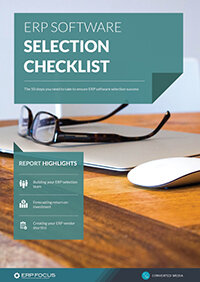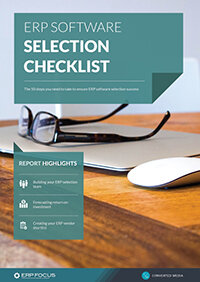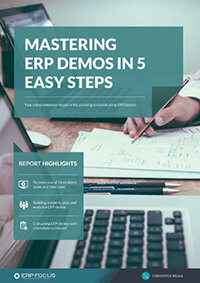What are the ERP tiers?
In this and other forums, many people use abbreviations, acronyms and all manner of shorthand in order to get as much information across in as little time as is possible. One thing that they do is to talk about 'tiers' of ERP systems, and 95% of the time that works well. The problems start when we get into gray areas because many marketing people see advantage in talking-up their systems and that results in everything from Tier 2 systems being sold as Tier 1, through to systems that are not ERP at all being sold under that label. This might not seem important but, when systems are oversold, somebody usually suffers and that somebody is usually the customer. This blog attempts to clarify matters but has to start off by saying that there is no universally accepted definition of what Tiers 1, 2, and 3 actually are; nor indeed what criteria should be used when categorizing them.
Different companies use different criteria when reviewing ERP systems; the most common of which are:
- Supplier size
- System cost
- Typical customer size
- Number of users supported
- Functionality
Investigating these, and investigating how they can overlap or contradict, may be useful because all will be seen to have their problems.
Supplier size
At first glance, this seems an eminently sensible approach because it seems obvious that the big systems will come from the big ERP providers. But although most people, when asked to name Tier 1 suppliers, will immediately name Oracle and SAP, it is not as easy as that because, whilst nobody would deny that, for example, SAP ECC is a Tier 1 system, equally nobody would claim that SAP Business One was.
And, as we get close to the border between Tier 1 and Tier 2, things become even more unclear. Microsoft is an enormous company but is Microsoft Dynamic 365 a Tier 1 system? Given that it is marketed as a replacement for a range of systems, from AX down to GP, the answer is not clear. Meanwhile, Infor is trying to position itself as a Tier 1 supplier but Sage is of equal size and clearly sees itself as a supplier of Tier 2 and 3 systems (and, indeed, as a supplier of accounting systems that are not ERP at all). And then there are suppliers like IFS, which is a company much smaller that Infor or Sage, but which would be considered by most other criteria to be a Tier 1 system.
Clearly, supplier size has a role to play in the calculation but it may not be a sufficiently good measure, so other criteria need to be considered as well.
System cost
This appears to be a better way to categorize because clearly the multi-million dollar top-end systems from Oracle and SAP are Tier 1. This definition also means that systems such as IFS and MSD365 can be categorized as Tier 1, but the problem comes when Tiers 2 and 3 are added to the mix. Then systems that have major gaps or limitations in their functionality can, if sufficiently expensive, fall into a higher category than can be otherwise justified. For example; SAP Business One, which is a Tier 2 when measured by cost, did not have an inventory module that recognized storage locations until very recently (because it is, at heart, an accounting system and, in an accounting system, it is not important where stock actually is: it is only important to know how much there is and how much it costs) ; whilst a system that out-scores it on functionality is available for less than a quarter of the price. So, if systems with Tier 3 functionality (see later for a definition of this criteria) are sold at Tier 2 prices, and systems with Tier 2 functionality are sold at Tier 3 prices, there is again a very gray area and it remains necessary to consider other options.
Use our ERP pricing guide to find the cost of popular ERP systems
Typical customer size
Once again this definition appears to make perfect sense because it would appear logical that big companies buy big (i.e. Tier 1) systems. But again it is not that simple because many big companies have realized that they are actually big because they are a collection of small companies or separate operating units and have then decided to run Tier 2 or Tier 3 systems at that level and to consolidate financial data in a Tier 1 accounting system at a corporate level. It can make sense to do this for a number of reasons; not least of which is that Tier 1 systems can be overkill for smaller organizations; being too cumbersome and too complex for their needs.
However; some large organizations do impose such systems on smaller operating units and subsidiaries, so organization size may not always be an appropriate measure because it is not clear which actual organization is being measured.
Number of users supported
This is perhaps the best way to categorize ERP systems even though it is not perfect. Clearly a system that can only support, say, 25 users should be classified as a Tier 3, and a system that can support 5000 users can safely be classified as a Tier 1 (when talking about a number of users, it is usual to talk about 'concurrent' users; i.e. the number that can be logged on to the system at any one time: this can be significantly less than the total number of users authorized to use the system as some users will only require occasional access).
But once again there are gray areas. Firstly, even with 3 tiers there is room for a lot of difference between systems in the same tier; so some Tier 3 systems will run out of steam with 25 concurrent users whilst others will perform fine with 50. And some Tier 2 systems will struggle with 250 users whilst others will cope happily with one or two thousand.
The second problem is that much also depends upon the user company. Some will have a small number of transactions every day whilst others will have many thousands (imagine companies that sell capital equipment and others that have telesales departments selling consumer durables), and some will have small static data files (customers, products, bills of material etc) whilst others will not.
So although it is a good measure, it is only a good measure most of the time.
Functionality
Ironically, this is probably the best measure but it is also the most difficult to apply. Whilst it is reasonable to expect Tier 1 systems to be functionally rich, these systems are often subject to extensive, and expensive, customization because most companies that spend millions on Tier 1 systems want and expect a 'glove fit' and are willing to pay to get it. At the other end of the spectrum, companies that spend perhaps only thirty or forty thousand dollars on a Tier 3 system are usually more likely to accept its limitations and shortcomings; if only because it does not usually make sense to spend hundreds of thousands of dollars on customizing a $50,000 system.
A danger, when ranking systems by ERP functionality, is that some systems target niche markets and so a particular system might, for example, be considered a Tier 1 system by a distribution company but a Tier 2 system by a manufacturing company. Both of those categorizations, for the companies involved, would be valid.
Check out our top 20 ERP comparison guide for an overview of the best ERP systems available
All of this only really matters if companies are making shortlists or, worse, purchasing decisions based on the perceived tier ranking of competing systems. That can cause them to ignore systems that might be best suited for their needs in order to make a vanity purchase in order to feel that they are the equal of larger organizations Additionally there are organizations that neither want nor need full ERP functionality. Some may only want a financial system and find that a focused accounting system such as UNIT4 Agresso is better suited to their needs, Likewise, others may only want an HR or payroll system; so restricting their choices to ERP systems, and ignoring the specialist systems that cover these markets more completely, will not be a good idea.
ERP tier 1 vs ERP tier 2
The differences between ERP tier 1 and ERP tier 2 are dependent on the size, system cost, customer size, number of users, as well as the functionality of the system itself. Typically, we see tier 1 ERP built for large enterprise businesses.
It may be that, to get a good classification of a system, it is necessary to use a cocktail of the above definitions. Nevertheless, it is inevitable that categorization by tier is here to stay for the foreseeable future: so it is hoped that this blog has brought some clarity to commonly used definitions.
Free white paper

60-Step ERP Selection Checklist
Get the comprehensive checklist for your ERP selection project

Featured white papers
-

ERP Software Pricing Guide
Get the latest pricing information on over 80 popular ERP systems, and learn how to budget for your ERP project in our free guide
Download -

60-Step ERP Selection Checklist
Get the comprehensive checklist for your ERP selection project
Download -

ERP Demo Guide & Scorecard
Master your ERP demo with 5 easy steps using our free guide (includes demo scorecard)
Download
Related articles
-

The best ERP systems for process manufacturing
Consider these ERP systems when selecting your next process manufacturing ERP
-

Secret KPI: Why Your ERP Implementation Team Matters More Than Software
Learn how Godlan ensures successful ERP implementation for manufacturers with proven strategies &...
-

5 ERP pricing definitions you need to understand
Have you mastered the ERP pricing lexicon yet? Getting to grips with these five definitions is a ...

